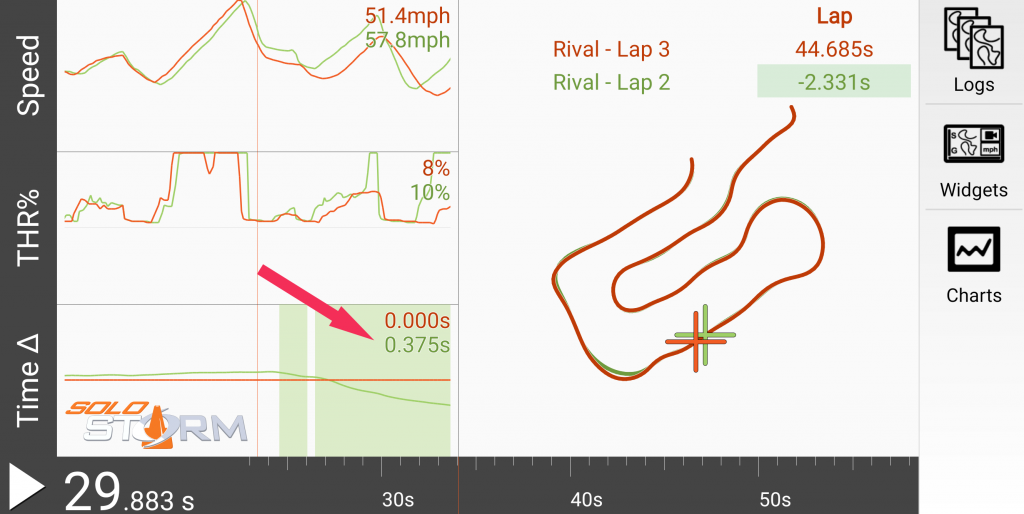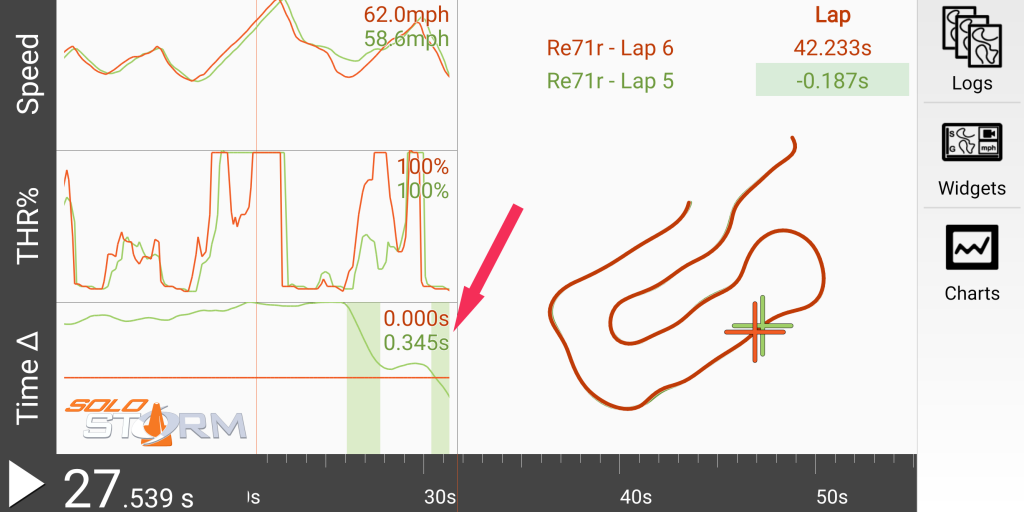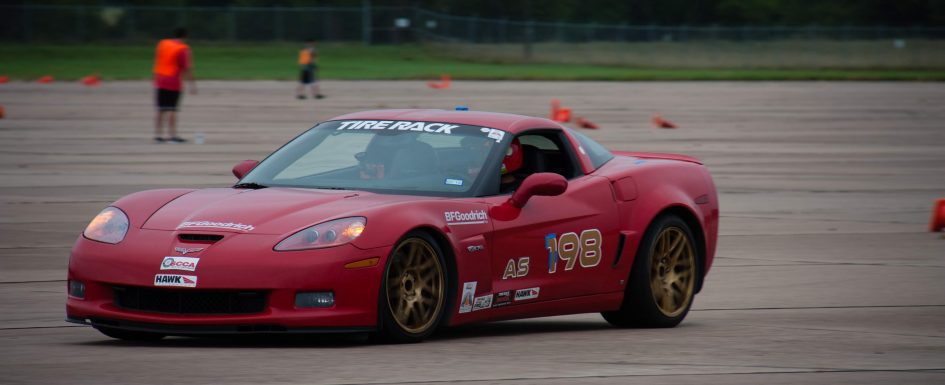Here are the results from round #1 (of 2) of my test of the top 2 autocross tires; the BFGoodrich Rival-S 1.5 vs the Bridgestone RE71R.
This was tested on my 2009 Corvette Z06 prepped for A-Street (Strano front sway bar, Koni 30-series double adjustable shocks).
Let’s get this out of the way first. Everyone has their own ideas of the “proper” way to test tires. Given unlimited runs, unlimited time, the ability to setup my own test course, etc etc, I may have done things differently. But given that my testing was during the course of a regular autocross event (I double entered), I did the best I could given the circumstances. If you’re not happy with how I did my testing, that’s totally cool, do your own tests and share your results!
Alright, here are the tires that were being tested…
- Bridgestone RE71R (275/35/18 front, 305/30/19 rear) on OEM Z06 wheels
- BFG Rival-S 1.5 (275/35/18 front, 335/30/18 rear) on Forgestar wheels
Both sets of tires were BRAND NEW.
For this round of testing, I did NOT change any shock settings throughout the day. As someone who has always driven on stock shocks (until now), I wanted to keep round #1 of the test simple and not twiddle with shock settings for each tire. I am aware that both tires like a slightly different setup (I am still determining what those differences are), and for round #2 in a few weeks, I will attempt to make the appropriate shock setting changes for each tire.
The format for the day of autocross was 2 heats, with 6 runs in each heat.
The course had a good mix of elements… high speed transitions, a couple of thread the needle risk/reward elements, sweepers of varying radii and size, and a short slalom.
The surface was medium grip asphalt.
Weather conditions: The morning started with the temps in the mid 70s, with the surface of the track damp in a few spots. By the third run, the track was completely dry. The second heat ran in the afternoon with the temps in the mid/high 80s.
My plan was to start the morning session with the RE71R’s for 3 runs, switch to the Rival-S 1.5 for 3 runs, and then switch the order for the afternoon, starting the the Rival-S 1.5 for 3 runs, finishing with the RE71R for 3 runs.
I’ll start with listing out the times for each run, and then give my commentary below.
Morning RE71R
Run #1: 45.278 (+1)
Run #2: 43.877 (+1)
Run #3: 43.284
Morning Rival-S 1.5
Run #4: 43.678 (+1)
Run #5: 43.367 (+1)
Run #6: 45.784 (+1)
Afternoon Rival-S 1.5
Run #7: 44.757
Run #8: 43.750 (+1)
Run #9: 43.450 (+2)
Afternoon RE71R
Run #10: 43.359
Run #11: 43.099
Run #12: 43.238 (1)
As I mentioned, the day started with the track a bit damp, hence the slower first run (a dirty 45.2). By the second run, the track was almost dry, except for a slightly slippery area in one critical spot (dirty 43.8). By the third run, the track was completely dry, and I set a time of 43.284 with the RE71R. I was reasonably happy with the run, figuring that a high 42 second run was possible.
I switched to the Rival-S 1.5, and ran a dirty 43.3 (just 1 tenth slower than the RE71R, but dirty) on my 2nd run on the tires (5th run overall). On the next run, I was on pace for a 43.0, but made a significant error, sliding significantly, and backed off for the last corner, hence the slower time.

My guess had been that the morning session would serve for scrubbing in both sets of tires, and that the afternoon session would be when I would set my fastest time with each tire. There was a 30 minute lunch break, so at no point did I get to run either tire for more than 3 runs in succession.
I started the afternoon on the Rival-S 1.5, expecting to go faster than the morning. However, everyone seemed to be going slower in the afternoon, myself included. The best I could manage in 3 runs was a dirty 43.4 (1 tenth slower than my time with the Rival-S in the morning).
I switched back to the RE71R for the final 3 runs, and immediately went faster than I had with the Rival-S 1.5. On the second run (11th overall) I set my fastest clean time of 43.099. This was almost 3 tenths quicker that my fastest dirty time with the Rival-S from the morning, and almost 4 tenths faster than my fastest dirty time with the Rival-S in the afternoon. The final run was on pace to be a 42.7, but I made another significant error where I slid way out of position, and hitting a cone in the process.

OVERALL IMPRESSIONS
Well, based on this one day, the RE71R appears to be ~3 tenths faster (on a 40ish second course) than the Rival-S 1.5, both in actual observed time, as well as in potential time from looking at data. The delta from my fastest RE71R time (43.099) to my fastest dirty Rival-S time (43.367 +1) was just under 3 tenths of a second, and the fastest potential times were also separated by 3 tenths (42.7 vs 43.0).
This begs the question… what does each tire do better? The peak grip levels are extremely similar, with the Rival-S appearing to have marginally higher steady state grip (1.24 g’s vs 1.21 g’s). The Rival-S 1.5 is noticeably better than the previous Rival-S longitudinally (I always felt like the previous Rival-S was great laterally, but not particularly good on corner exit). This time, corner exits were almost identical with both the RE71R and Rival-S 1.5.
So if the Rival-S 1.5 grips so well, what made me faster on the RE71R?
3 things…
- I found it easier to place the car more accurately on the RE71R.
- On the RE71R, I recovered from mistakes more quickly.
- I preferred the overall handling balance on the RE71R, with the car rotating more readily.
I think there are some subtleties to be mindful of here.
First, I have a bit of a hair-on-fire driving style. It is possible that the RE71R works better for me because it makes up for some of my lack of precision. Drivers that are more innately precise may do just fine (or better) on the Rival-S 1.5. Second, the Rival-S 1.5 continues to provide really good lateral grip even while sliding, but longitudinal grip suffers, which (for me) makes it harder to recover from slides, causing greater lost time. Third, with the 30mm narrower rear tire, I much preferred the handling balance with the RE71R. I was able to make the car rotate more easily without feeling like I was forcing the car to rotate. My driving style tends to favor a car that rotates a bit more on corner entry, so this may not be for everyone.
I have not tested the RE71R against the previous generation Rival-S, so I don’t have any real world first hand commentary on that, but I’m assuming the Rival-S 1.5 version is better than the previous version.
I do not consider this test conclusive (yet)
Take all of this as a data point. But I caution against drawing too many conclusions from this one day just yet, for the following reasons:
- This test was on medium grip asphalt. It remains to be seen how the tires perform on higher grip concrete.
- The shock settings were not optimized for each tire. There is likely some fine tuning needed to work out what each tire likes best.
- Different cars have different strengths. So the test results on a Corvette do not necessarily apply to a Miata.
- Driving style matters a lot. My results may not be the same as your results.
For round #2 of testing in a couple of weeks, two things will be different…
- I will try to work out shock settings to match the preference of each tire.
- That test will be on the much higher grip of Lincoln-like concrete.


One factor, not relevant to your test perhaps, but for many considering which tire to buy the BFGs are available in far fewer sizes than the RE-71Rs are.
Wow, I get the feeling that this is a very good test as you seem to be very aware of and quite honest in your assessments of your abilities and driving style! Thank you for that! Excellent work.
as said, your results may vary; FWD puts maximum demands on tire; 4WD spreads those demands out; RWD seems to maybe fall in between; MDonahue seemed to believe that skid pad was best to evaluating tires/suspensions, and minimize course variables…
Neil, I have mixed feelings about the use of a skidpad to evaluate a tire. My thought is that a skidpad is good for evaluating how good a tire is at steady state grip. The issue with that though is it tells an incomplete story. Only one portion of what we do involves steady state grip. A skidpad cannot tell us about transient behavior, how well the tire puts power down, etc. At the end of the day, I am less interested in which tire performs the best on a skidpad, and more interested in which tire results in the lowest lap time on an actual course, because that’s what we compete on.
Air pressures?
Rival-S: 30 psi all around
RE71R: 29 psi front, 30 psi rear
That seems low to me. When I got new Rival-s 1.5 ‘s I did the chalk marks on the sidewall diamonds. With anything below 32 psi the sidewalls wanted to roll and rub off the chalk. I run my Miata at 32 psi cold and try to keep the hot pressures around 35 to 36. Maybe the Vet’s run lower?
This is interesting, I started running Rivals last summer on my Miata when I couldn’t get any RE-71’s, I also started using an IR temp gauge to monitor temps across the tire after a run. In my experience it seems like the temps were more even across the Rivals when running 35~ish psi as opposed to the 30-32 psi I was running. Now that thee car (finally) has an alignment I’ll be interested to see how they perform once the temps start to come up.
I really like the grip of the RE-71R’s on both the autocross and TT situations. We have worn our numerous RE-71R’s in Endurance racing and feel they behave well all the way to cord (at which time it’s obvious it’s time to change). Actually on the Miata we found that an 8 hour endurance does not require a tire change on a RE-71 R. (Especially if the tires have already had one heat cycle).
I have another theory that may be a factor… You ran 30mm wider tires for the rivals than the RE71R… in my experience, I’ve actually found a bit narrower to be advantageous with the RE71R in autocross… I attribute this to them being able to heat up quicker, which is even more important in a 40 second autocross run. Just something else to consider… I think that in autocross specifically, wider may not always be better…it really comes down to the data, and the temperatures that the tires are getting up to during your runs.
Ideally I would have tested the same sizes on the rear, but the same sizes are not available.
Gotta agree with Keaton: testing a 305/30/19 tire against a 335/30/18 tire invalidates the comparison right from the start. It doesn’t matter that those were the sizes the author could find for the car. This “test” doesn’t compare apples to apples. Should have used a car for which the same size tire could be found for both brands. If you test the same make & model tire in two different sizes, might you expect that you would get different timed results? Any differences in times could be attributable to the different sizes alone.